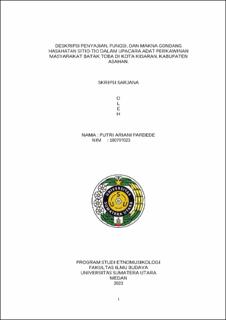| dc.description.abstract | The traditional marriage ceremony is a culture that is still carried out by the Toba
Batak community in Kisaran city, Asahan district. Even though the Toba Batak people are a
minority, this does not constitute an obstacle for them in carrying out their customs and
culture. Gondang hasahatan sitio-tio is the name of the Batak gondang repertoire which must
be played as a closing ceremony in traditional wedding ceremonies and gondang is also
believed to convey hopes and prayers to the Almighty. The aim of this research is to describe
how the gondang hasahatan sitio-tio repertoire is presented, what the function and meaning of
the repertoire is, and describe the musical structure of the repertoire. The method the author
uses is a qualitative descriptive method which includes literature study, field work, interviews
and laboratory work. The theory that the author uses in describing function is Use And
Function proposed by Alan P. Meriam, to describe meaning the author uses a connotative and
denotative approach, namely through the umpasa used by the king of parhata before asking
the gondang hasahatan sitio-tio to be played. To describe the musical structure of this
repertoire the author uses the weighted scale theory approach proposed by William P. Malm,
and to describe traditional ceremonies the author uses the ceremonial description theory
approach proposed by Koentjaraningrat. The results obtained from this research are that the
traditional marriage ceremony of the Batak Toba community is carried out through three
processes, namely the stage before the ceremony, the stage of carrying out the ceremony, and
the stage after carrying out the ceremony. The presentation of gondang hasahatan sitio-tio is
served to end every activity in the ceremony which uses music and is requested by mar
umpasa. There are several functions of gondang hasahatan sitio-tio in the traditional marriage
ceremony of the Toba Batak community in the city of Kisaran, namely the communication
function, the function of physical reactions , cultural continuity function, and symbolic
function. The meaning of gondang hasahatan sitio-tio, why it must always be played and
cannot even be omitted, is because gondang hasahatan sitio-tio is an intermediary for prayers
and all the hopes conveyed by all parties participating in the ceremony to the Almighty and
hopefully they can be granted through gondang hasahatan sitio-tio. Gondang hasahatan sitiotio
is played on the basic note Es with a vivace tempo. | en_US |


